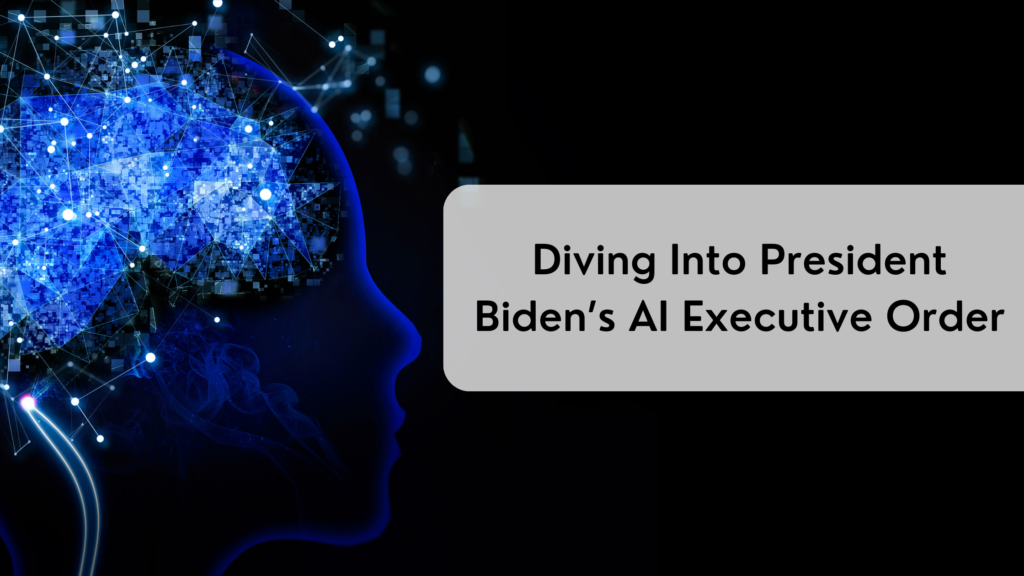
Diving Into President Biden’s AI Executive Order
On October 30th, President Joe Biden unveiled the federal government’s most comprehensive initiative regarding artificial intelligence (AI) to date. The Executive Order on the Safe, Secure, and Trustworthy Development and Use of Artificial Intelligence order places a significant emphasis on establishing standards for AI privacy, security, and safety, as indicated in a preliminary fact sheet that preceded the official order. It also aims to combat discrimination within AI systems while safeguarding the rights of workers when AI technology is deployed in the workplace.
Bruce Reed, the White House Deputy Chief of Staff, expressed that Biden’s actions represent the most substantial measures any government worldwide has taken to ensure AI’s safety, security, and trust. He underscored that these steps are part of an aggressive strategy to harness the benefits of AI while mitigating potential risks.
President Biden had pledged to address AI-related issues in August, leaving privacy and cybersecurity professionals wondering what was coming down the pike. In the lead-up to this executive order, Biden secured voluntary commitments from several companies to adhere to safety metrics while awaiting more formal regulations from the U.S. Congress. Additionally, earlier in the year, the White House had unveiled a Blueprint for an AI Bill of Rights.
Prior to signing the executive order, President Biden spoke about the significant responsibility the federal government faces in establishing guidelines for a technology that can take various forms and is rapidly evolving. He described this moment in history as an “inflection point” where current decisions will have far-reaching consequences, which could be both perilous and transformative, including the potential to combat diseases like cancer and address climate change.
About the Order
The executive order’s primary focus is the integration of privacy and AI, highlighting the essential need for safeguards. The order explicitly calls on Congress to advance comprehensive privacy legislation, echoing the sentiments of federal lawmakers who have recently explored the connection between privacy legislation and AI regulation.
Under the order, federal agencies are directed to develop techniques to protect individuals’ privacy, assess the effectiveness of existing privacy protections, and strike a balance between data accessibility for training purposes and data security and anonymity.
The order also tasks the National Science Foundation with collaborating on stronger cryptography protections to safeguard privacy and national security, particularly in the face of advancing quantum computing. Federal agencies are instructed to assess their data collection and usage practices, including data obtained from data brokers, with the goal of ensuring data security.
The Future of Privacy Forum supports the call for bipartisan privacy legislation and views the executive order as highly comprehensive, affecting both the government and private sector. The Center for Democracy and Technology also applauds the order for its comprehensive approach to responsible AI development and governance.
To ensure safety, the order utilizes the Defense Production Act to compel developers to share safety test results with the government before releasing AI technologies to the public. It also establishes standards for these tests and instructs agencies like the Departments of Energy and Homeland Security to evaluate AI’s potential risks to critical infrastructure. The order further charges the National Security Council with developing a national memorandum on AI use in the military and intelligence community.
The order emphasizes the need for accountability among companies as scrutiny increases regarding how generative AI algorithms create content. To maintain transparency, it calls for independent testing of AI safety and the establishment of new standards for collaboration between the government and private sector.
The executive order builds upon Biden’s Blueprint for an AI Bill of Rights by requiring agencies to issue guidance on the use of AI in sectors like housing, federal benefits programs, and contracting to reduce discrimination. This move follows studies demonstrating that algorithms used in areas like banking can harm low-income borrowers.
The Department of Justice is tasked with training civil rights offices on prosecuting civil rights violations related to AI and setting standards for AI usage in the criminal justice system, ensuring equitable practices.
The order also prioritizes protecting workers’ ability to collectively bargain, addressing job displacement due to AI, and upholding labor standards. It encourages companies to distinguish AI-generated content from human-created content by adding watermarks.
Furthermore, the order underscores the importance of promoting U.S. competitiveness in AI. It calls for the establishment of a National AI Research Resource to enhance research tools’ accessibility and provide technical assistance to small businesses. Streamlining the visa process for AI-skilled individuals to study and work in the U.S. is another key feature.
While President Biden’s executive order represents a significant step forward, it also acknowledges that there are limits to what the White House can accomplish independently. With mounting pressure and rapid global developments in AI, Congress faces the challenge of keeping pace with the evolving landscape.
